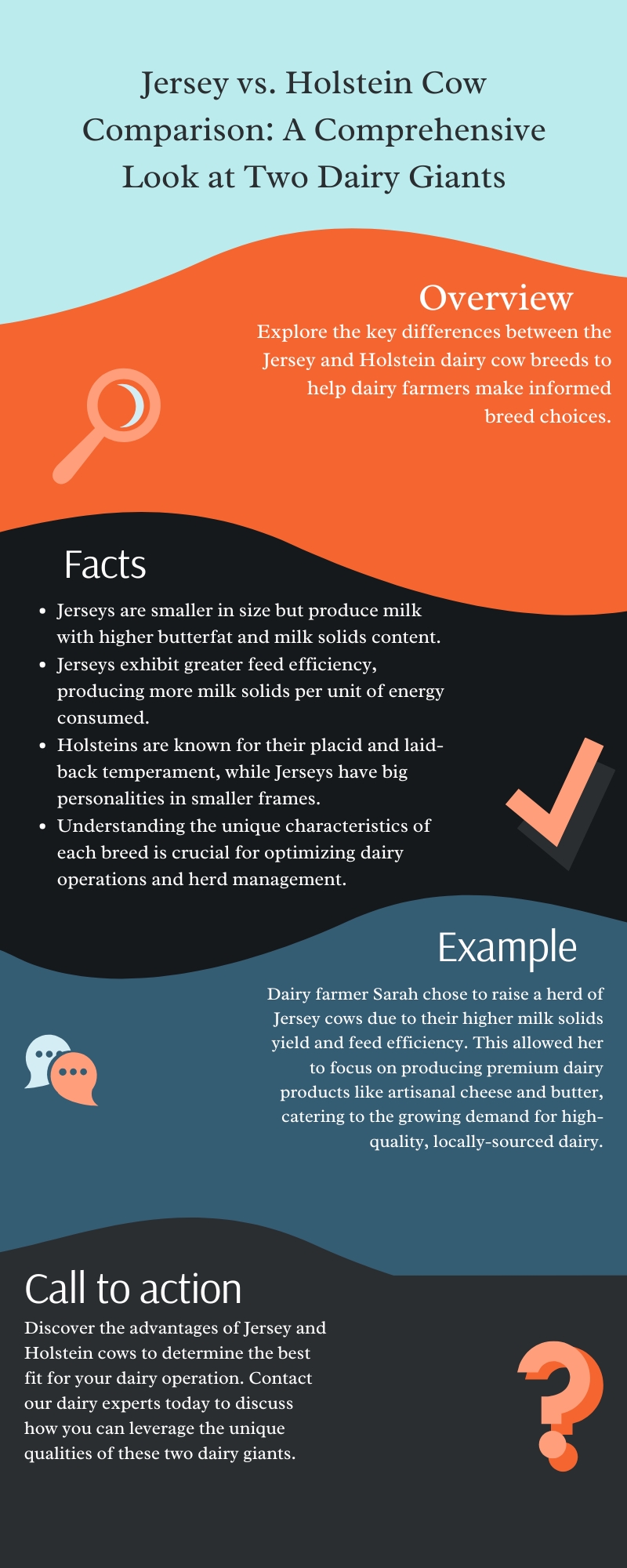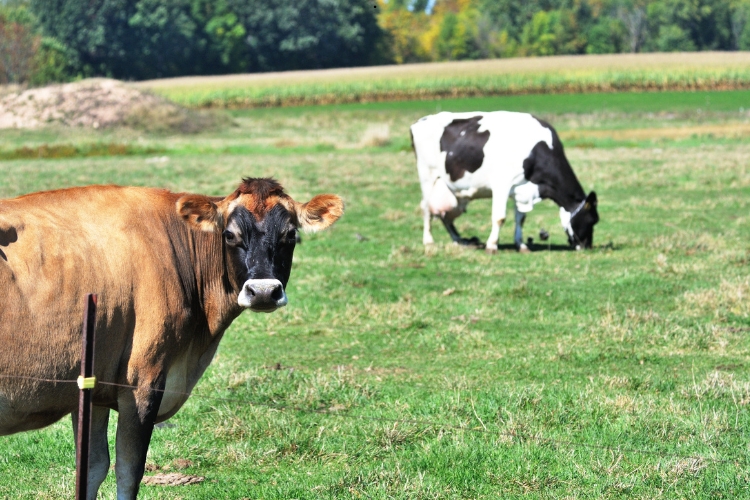In the captivating world of dairy farming, two breeds reign supreme: the Jersey and the Holstein. While the striking black-and-white pattern of the Holstein might be the more familiar sight, both breeds possess unique and remarkable qualities that contribute to their enduring popularity.
This blog article will explore the similarities and differences between these two dairy powerhouses, delving into their physical attributes, milk production, feed efficiency, temperament, and more.
Key Takeaways!
| Feature | Jersey | Holstein |
|---|---|---|
| Size | Smaller in size | Larger in size |
| Milk Composition | High butterfat and milk solids content | Lower butterfat and milk solids content |
| Feed Efficiency | Greater feed efficiency, producing more milk solids per unit of energy consumed | Moderate feed efficiency |
| Maintenance Energy Requirements | Higher maintenance energy requirements | Lower maintenance energy requirements |
| Temperament | Big personalities in smaller frames | Placid and laid-back temperament |
| Use Case | Best for high milk solids production | Best for high milk volume production |
Physical Characteristics
Choosing the right dairy breed starts with understanding their physical traits. Jerseys and Holsteins differ significantly in size, coat patterns, and head shape, which influences their management and appeal.
1. Size and Weight
- Holsteins: Largest dairy breed, with mature cows often exceeding 1,500 pounds.
- Jerseys: Smallest dairy breed, typically weighing around 1,200 pounds.
- Impact: Size influences housing requirements and feed intake.
2. Coat Color and Patterns
- Holsteins: Distinctive black-and-white or red-and-white coat patterns; each pattern is unique, much like fingerprints.
- Jerseys: Shades of brown ranging from pale white or grey to deep fawn. Common features include black hooves and grey tongues.
3. Head Shape
- Holsteins: Large heads with a classic “cow head” appearance; gentle and traditional look.
- Jerseys: A subtle V-shaped “dish” in their face, making their eyes appear larger and more prominent, adding to their endearing charm.
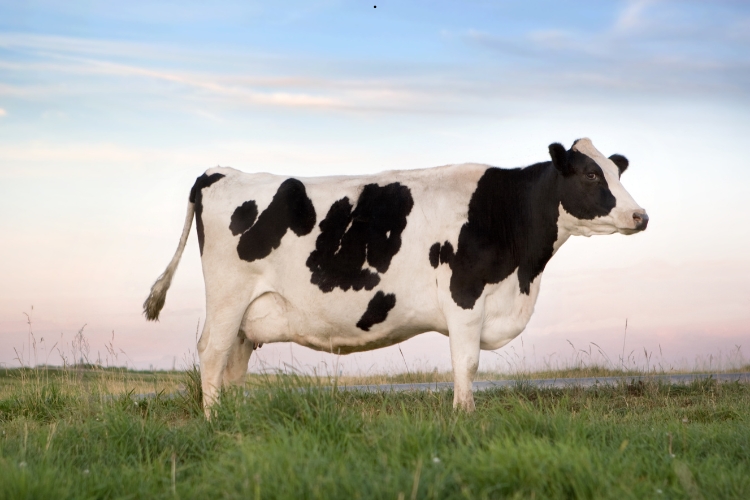
Milk Production and Composition
Milk production is a key factor in dairy farming. While both breeds excel in their ways, the differences in milk fat content and solids yield can guide farmers’ choices, if you want to read more in detail read from here.
1. Milk Fat Content
- Jerseys: Average butterfat content of 4.8%, lending their milk a yellowish tinge and creamier taste. Ideal for premium dairy products like cheese, butter, and ice cream.
- Holsteins: Lower butterfat content at approximately 3.7%, resulting in a whiter appearance.
2. Milk Solids Yield
- Jerseys: Produce more milk solids per pound of body weight due to higher fat and protein concentration.
- Holsteins: Higher overall milk volume but lower solids yield compared to Jerseys.
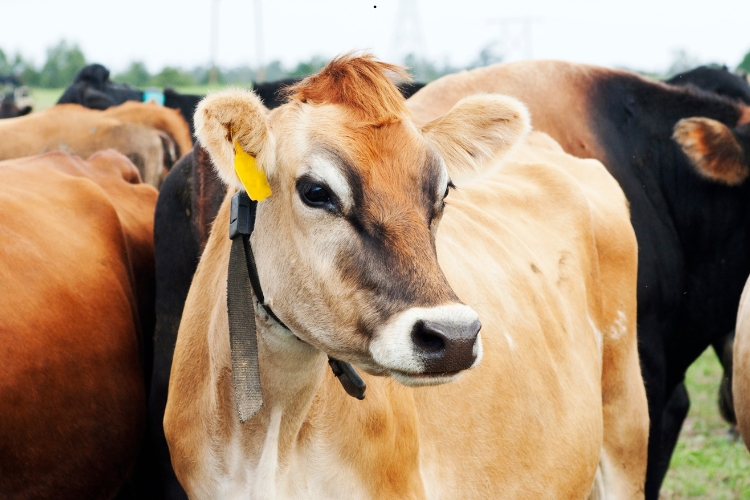
Feed Efficiency and Nutrition
Efficient feed conversion is vital for profitability. Jerseys and Holsteins differ in their feed efficiency, digestion, and dietary needs.
1. Feed Efficiency
- Jerseys: Highly efficient, converting forage into milk energy effectively. Their milk energy output is higher due to the increased milk solids content.
- Holsteins: Moderate feed efficiency but can consume larger volumes due to their size.
2. Dry Matter Intake (DMI) and Digestion
- Jerseys: Higher DMI per unit of body weight. Efficient digestion supports their feed efficiency and milk production.
- Holsteins: Lower DMI relative to body weight but still effective for high milk production.
3. Ration Fiber Content
- Jerseys: Higher milk fat content may benefit from diets with more fiber. However, excessive fiber intake can limit their DMI.
- Holsteins: Typically thrive on balanced fiber and starch levels without specific requirements for higher fiber.
4. Milk Fever and Transition Diets
- Jerseys: Higher risk of milk fever due to fewer vitamin D receptors affecting calcium absorption. Recommended transition diets with lower cation-anion difference and target urine pH of 5.8-6.2.
- Holsteins: Lower milk fever risk. Transition diets should aim for a urine pH of 6.2-6.7.
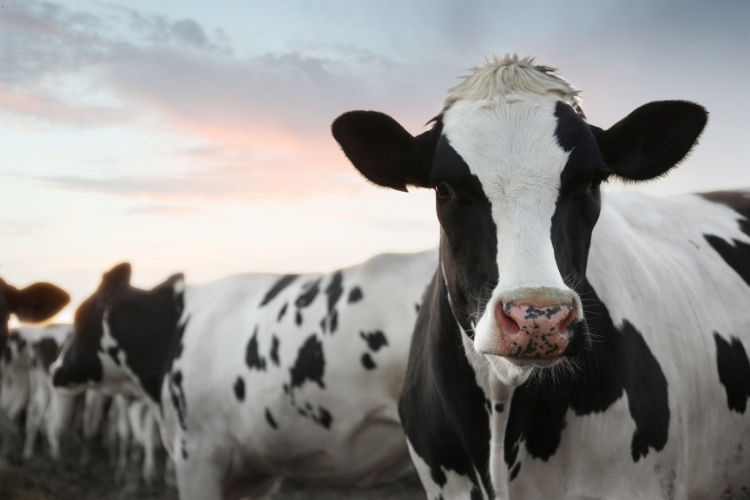
Temperament and Personality
A cow’s temperament affects its handling and overall farm operations. Jerseys and Holsteins exhibit distinct behavioral traits.
1. Holstein Temperament
- Placid and laid-back demeanor.
- Observant but less reactive, often giving a calm “side-eye.”
2. Jersey Temperament
- Energetic and curious, often described as having “big personalities” in small frames.
- Friendly but can be sassy or stubborn, making them more assertive in interactions.
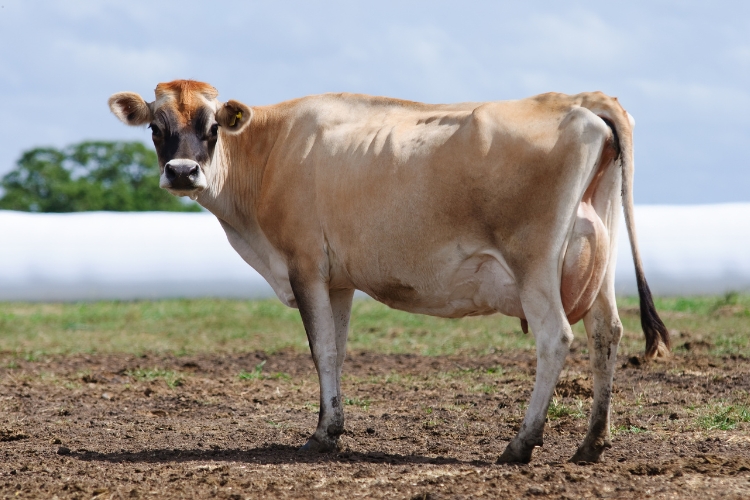
Comparative Summary
To summarize the key differences between Jersey and Holstein cows, the following table provides a quick overview:
| Characteristic | Jersey | Holstein |
|---|---|---|
| Size and Weight | Smaller, typically 1,200 lbs | Larger, often exceeding 1,500 lbs |
| Coat Color and Patterns | Range of brown shades, black hooves, grey tongue | Distinctive black and white (or red and white) pattern |
| Head Shape | “Dish” face with larger, more prominent eyes | Classic “cow head” appearance |
| Milk Fat Content | Higher, around 4.8% | Lower, around 3.7% |
| Milk Solids Yield | Higher per pound of body weight | Lower per pound of body weight |
| Feed Efficiency | Higher efficiency in converting feed to milk solids | Lower efficiency compared to Jersey |
| Temperament | Curious, and friendly, but can be sassy and stubborn | Placid, laid-back, and less reactive |
Conclusion
Jersey and Holstein cows have earned their place as leading dairy breeds, each bringing unique strengths to the industry. Jerseys excel in milk solids yield and feed efficiency, while Holsteins boast higher milk volume production.
Their contrasting temperaments further add to their appeal. Ultimately, the choice between a Jersey or Holstein depends on the specific needs and preferences of the dairy farmer. Both breeds continue to play a vital role in providing consumers with high-quality milk and dairy products worldwide.
As the dairy industry continues to evolve, understanding the nuances between these two dairy giants can help farmers make informed decisions and capitalize on the unique qualities of each breed. By recognizing the advantages and challenges associated with Jerseys and Holsteins, dairy professionals can optimize their operations, enhance herd management, and ultimately deliver the best dairy products to consumers.
FAQs
What are the main physical differences between Jersey and Holstein cows?
Holsteins are larger (over 1,500 lbs) with black-and-white or red-and-white coats, while Jerseys are smaller (around 1,200 lbs) with brown coats. Jerseys also have larger eyes and a “dish” face, unlike Holsteins’ classic cow head.
How do Jersey and Holstein cows differ in milk production and composition?
Jersey milk has higher fat content (4.8%) and is creamier, while Holstein milk has lower fat (3.7%) but higher volume. Jerseys produce more milk solids per pound of body weight.
What are the differences in feed efficiency and nutritional needs?
Jerseys are more feed-efficient, converting energy into milk solids better. They consume more dry matter per body weight but are prone to milk fever, needing special transition diets.
How do their temperaments differ?
Holsteins are calm and laid-back, while Jerseys are curious, friendly, and sometimes sassy or stubborn. Jerseys are more assertive and interactive due to their smaller size and bold nature.
